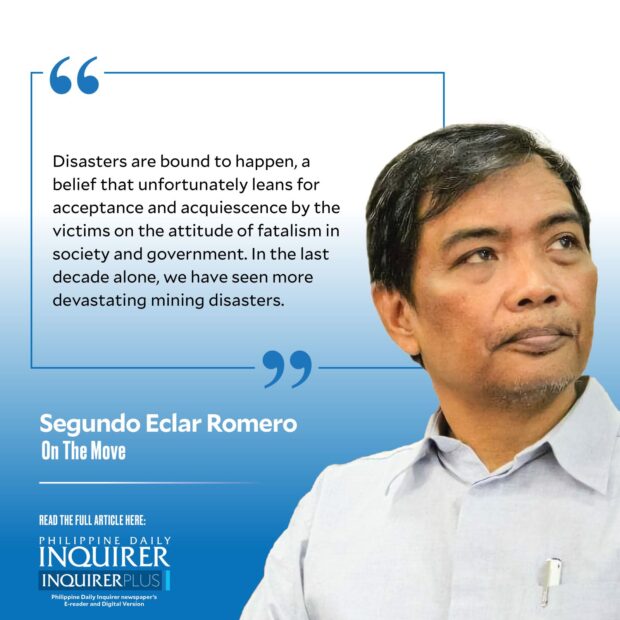Mining disasters: Enough is enough

Last Saturday, yet another mining disaster occurred. The tailings storage facility of the Siana Gold mine operated by Greenstone Resources Corp. (GRC) collapsed, burying houses in the mining village of Siana, Mainit, Surigao del Norte. Some 55 families fled to safety. Luckily, no casualties were recorded.
What piqued my curiosity in the news report was how GRC blamed the collapse of their tailing storage facility on recent earthquakes, the latest of which included the magnitude 4 earthquake that happened hours before the landslide.
This kind of reasoning and excuse has been used by mining companies in the Philippines to escape responsibility for the damage they cause to the environment and the deaths, injuries, and chaos they visit upon the people in mining communities. They get away with nary a slap on the wrist because, well, the high seismicity of the country is to blame. Disasters are bound to happen, a belief that unfortunately leans for acceptance and acquiescence by the victims on the attitude of fatalism in society and government.
In the last decade alone, we have seen more devastating mining disasters. On Aug. 1, 2012, Philex Mining Corp.’s Padcal Mine in Benguet released 20.6 million metric tons of toxic waste, the largest in the country’s history. On Sept. 8, 2008, heavy monsoon rains triggered a landslide in Compostela Valley, burying a mining village and killing 14 people. On Feb. 13, 2013, a landslide in Semirara Coal Mine in Antique, the largest coal mine in the country, killed five workers. On Feb. 6, 2024, a landslide in a gold mine in Masara, Davao de Oro, claimed nearly 100 lives and buried homes.
In all these cases, there had been calls for accountability from the mining company and government. But all the mining companies need to do is to “dribble the ball” and let more sensational news bury the painful memory of the event.
And so, we see layers of devastating consequences of mining disasters piling on one another, with no closure, only personal acquiescence to the march of death and the persistent suffering from chemical, biological, and physical damage to humans and their communities.
The Marcopper and Placer Dome mining disasters in Marinduque, particularly the 1996 Boac River spill, are often referred to as the “mother of all mining disasters” in the Philippines due to their devastating and long-lasting environmental and social impacts.
From 1975 to 1991, millions of tons of mine tailings leaked into Calancan Bay, contaminating the marine ecosystem and impacting fishing communities. In 1996, a drainage tunnel collapse released 1.6 million cubic meters of toxic tailings into the Boac River, flooding downstream areas, destroying crops, and severely polluting the river system.
I had a close look at the effects of the Marinduque mining disasters when I was commissioned by the Department of Science and Technology to write the book “Science for the People: Helping People Help Themselves” (https://rb.gy/llwypq). The chapter on “Science ‘Magic,’ In Mogpog: Greening Barren Mined-Out Areas” extols the heroic efforts of scientists like Dr. Nelly Aggangan of the University of the Philippines Los Baños to innovate bioremediation measures to make the devastated “brownfield” area more habitable. But the remediation task is painfully dwarfed by the scale of the disaster. Why can’t we just prevent these disasters from happening in the first place?
The lessons we should have learned from the Marinduque and other mining disasters are several: (1) these disasters highlighted the need for stricter environmental regulations and stronger enforcement mechanisms for the mining industry in the Philippines; (2) companies must prioritize safety and environmental protection throughout the entire mining lifecycle, from exploration to closure; mining companies must be held accountable for the social and environmental impacts of their operations, including long-term health and ecological consequences; (3) meaningful engagement with local communities is essential to ensure their concerns are heard and addressed in mining projects; and (4) adequate resources and long-term commitment are necessary to restore damaged ecosystems and support affected communities.
The first task is to compile a registry of all of these potential brownfields (land) and bluefields (water) and the personal and juridical persons responsible for them and set them up for close and strict anticipatory monitoring and evaluation by the government based on the law and the affected communities themselves using social audit methods.
The Philippines’ vulnerability to earthquakes and its archipelago geography should not be excuses for inaction. It is imperative to map all brownfield and bluefield polluted sites in the country, enabling us to anticipate and prevent future disasters. We must break free from the cycle of reaction and embrace proactive measures to protect our environment and communities.
doyromero@gmail.com




















